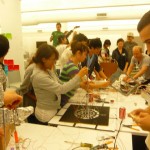The readings this week were nothing new to me. Coming from a landscape architecture background, the issues brought up in these readings were prominent ones that we had to deal with extensively. In order to be able to design a public space the first thing would always be to dissect and understand peoples interactions within the existing space and similar ones. This was considered our “site analysis”, which was always the initial step to any landscape design, and in some cases the most important and extensive. To come up with a great landscape design, one must first understand the space and its inhabitants.
In the article “Cultural Probes” by Dunn & Gaver, they really needed to understand their demographic and change their approach accordingly. Materials were used to open a dialogue with the elderly. One example is the postcards used which seemed to be effective because of their informal communication tactic. The demographic may seem like a barrier, but they put a positive light on it saying that the elderly have a lifetime of knowledge and the spare time to contribute. I feel like I understand these challenges and solutions because in my last semester at Cornell we had a community-based studio. For this I had to work on re-designing a local park in Utica, NY. The most time-consuming and difficult part of the project was the analysis – basically getting feedback from community members so we could design a park to better serve them. There were several barriers we faced: one being the fact that this was a project located two hours away from my school (so it was a trip to get there), and another being the surrounding area of the park (senior housing and a center for the visually impaired). I had to try and understand the park from a blind persons perspective, and design with them in mind. To get feedback we went and talked to users of the park, and collected survey information. It was difficult to take into account the different requests and opinions we got, and to try to design with every community member in mind. We spent the whole semester working with the community and it is still an ongoing project taken on by the Rust2Green initiative. Although it was extremely difficult and frustrating at times, this was probably one of the best academic experience I’ve had. I learned firsthand how to effectively communicate with a variety of people and use this communication to design a space for those people.
“The Social Life of Small Urban Spaces” by William Whyte was also something very familiar to me from my landscape architecture background. The author specifically discusses plaza space, which to me is one of the most interesting types of space for an urban center like New York City. It has become so integrated into city life that we often don’t even think about plazas anymore, but if we were to imagine the city without them it would function in a vastly different way. An interesting point made in the reading was that contrary to popular belief, people use plazas to be part of the city, not to escape from it. Whyte discusses attributes ranging from line of sight, to seating space, to street performers, to handicap accessibility. I can relate to the reading very much because all of the factors he considered in his analysis are similar to ones I’ve had to consider. A well designed space is one that is accessible to all people, and flexible enough to change depending on the users. This is where his point about movable furniture becomes important, as well as dual-functionality for flat surfaces (can be used as ledges, seating, or as tables). These relate to a crucial aspect of any design, which is choice. Choice factors into many designs, and in this case the more choice their is the easier it is to appeal to a variety of users.
Basically, Whyte’s analysis of plaza space is extremely in-depth and insightful, and is a great example of understanding space. There are far more aspects to take into account than most people realize, but they are all important components to analyze. The first reading, Cultural Probes, depicts effective forms of communication in order to understand the user group and their relationship to the space. Both are great examples of analysis that should be done when designing a space for specific user groups. This is also true of designing anything that is already existing, as its existing conditions must be fully understood to attain a better design. These principles can be applied to many of our future designs, and I can definitely see how they will help us along in our next project.





Comments!